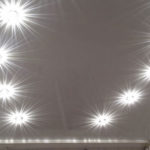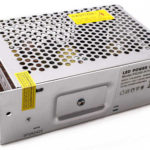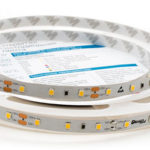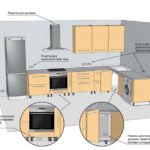A multi-level lighting system in the kitchen is the key to success. In other words, the kitchen should be divided into work areas. For example, areas for washing dishes, eating, places for working with products should be properly lit, and not according to the principle "the more the better." Let's deal with creating the right lighting for workspaces.
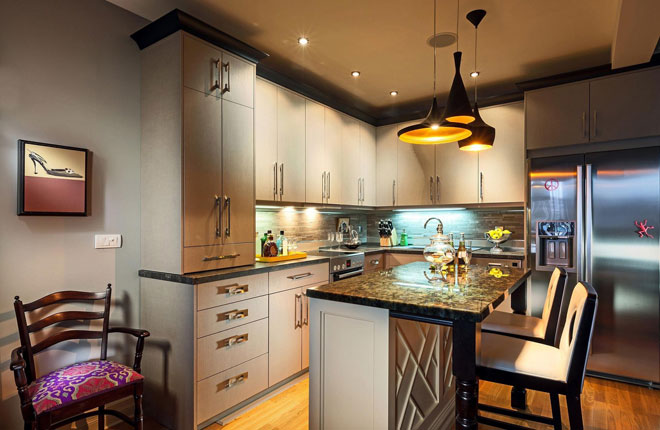
Content
Requirements and standards for lighting in the kitchen
The first step is to draw up a layout plan. Consider whether you want to visually expand the room or, conversely, reduce it and make it cozy.
This is not an easy task. Many factors will have to be taken into account:
- Avoid too much and too little light. Too much will blind. The disadvantage will spoil the vision when working with products, for example.
- Choose your lighting fixtures wisely.If there are a lot of lamps, their power should be less than if you had one lamp for the entire kitchen.
- Gone are the days of light bulbs hanging from the ceiling. Do not be afraid to experiment with LED strips, decorative lamps.
- Keep color balance. If the room is dark, the light reflection will not exceed 12-15%. Light colors reflect up to 80% of light. This can be used to reflect the flow of light in the desired direction.
- Do not place electrical components near water sources. The minimum distance is 600 mm.
- The recommended lighting power for the food handling area is 100 W/m2. For dining space - 40-50 W / m2.
Interesting! Sometimes the dining area is equipped with lamps hanging over the table. If the size of the room allows you to place the lamp in this way, try it! This will create a cozy atmosphere in the room.
If you need accurate calculations, there is a formula to help you determine how much light your kitchen needs. Knowing that the minimum level of illumination is 150 lux will help in making calculations.
Starting from this value:
150 × m2 = required number of lumens in lighting fixtures.
Example converting lux to lumens:
- Kitchen area is 20 m2.
- We multiply the minimum allowable degree of illumination by the area of \u200b\u200bthe room and get the number of lumens.
- 150 × 20 = 3,000 lm.
Then the lumens are converted to watts and the required number of light bulbs is calculated depending on their variety - incandescent, fluorescent, LED. There are hundreds of tables with detailed translations on the Internet. After reviewing them, you will find the optimal lighting fixtures in the right quantity for the kitchen.
Organization of general lighting in the kitchen
When organizing general lighting in the kitchen, you need to take into account its naturalness. In order for the room to be sufficiently light during the daytime, translucent or transparent blinds or curtains are selected.
But they are not recommended for kitchens on the first floors, where every passer-by can see what is happening inside. What then to do?
You should start with multi-level ceilings. Using them, you will achieve the desired effect, if only because with their help you can hide the LED strip, direct the light in the desired direction, or completely separate the zones.
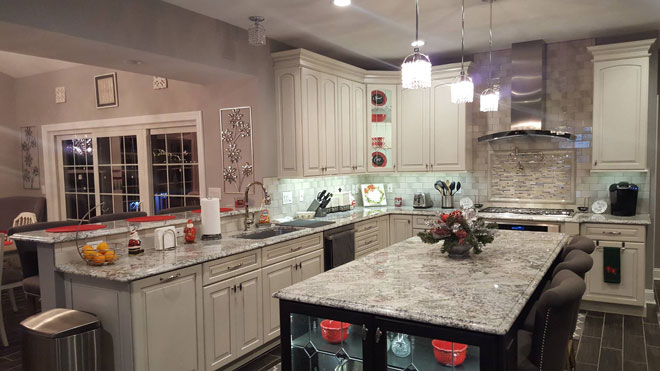
Creating general light in the kitchen can be achieved with classic chandeliers or creeping shades. A few tips:
- The former are recommended to be installed in kitchens with high ceilings, the latter in small rooms.
- If the kitchen is long, ceiling lamps or lamps can be installed in one row. So allocate, for example, dining areas.
- Ceiling lamps looking down will only be able to illuminate the space below them. If the ceiling is light, their rays are directed upwards. The light will be reflected, scattering around the room.
Work area lighting
The place where you work on cutting meat, vegetables, fruits and other products should be better lit than any other place in the kitchen. This is necessary to prevent visual impairment and accidental cuts during work.
If you have a row of cabinets above your work area, this can be played to your advantage. On their bottom it is possible run led strip, which, by the way, is the most affordable option. In addition, there are LED strips with a wall regulator.With it, the brightness is adjusted, the modes and colors are adjusted. By choosing this lighting option, you will sufficiently illuminate the surface for work.
But it is not recommended to overdo it with the amount of light. No less disastrous outcome will be the direction of the flow of light in the face. Beams should fall strictly on the work surface, NOT up, to the side or wall.
Interesting! Search online or in furniture stores for cabinets with built-in lighting fixtures. This is an alternative to LED strip.
Another idea is to use hanging lights, which we already mentioned. They are suitable for highlighting any place, whether it is a dining area or a place to work with products.
Dining area lighting
In no case should the place of eating be lit brighter than the general space and working area of the kitchen. It is recommended to select lighting that is discreet, possibly muffled, so that it does not embarrass people sitting at the table and does not hurt the eyes. But conversations about what is right and what is not must be supported by facts.
And here are a few rules that are optional, but in some cases they are indispensable:
- consider how the table is located in relation to the window openings;
- try to use natural light to the maximum by setting the table closer to the windows;
- if installing a table by the window is not possible, you can put it against the wall, illuminating it with a couple of wall sconces.
For tables located in the center of the room, hanging lamps and lamps with adjustable height are suitable. This option is combined with any size and structural features.
However, sconce lamps and small kitchens are the golden mean, no matter what. There are also mini-lamps and table-type lamps that are mounted directly on the surface of the table. But this comes at the expense of space on this very table.
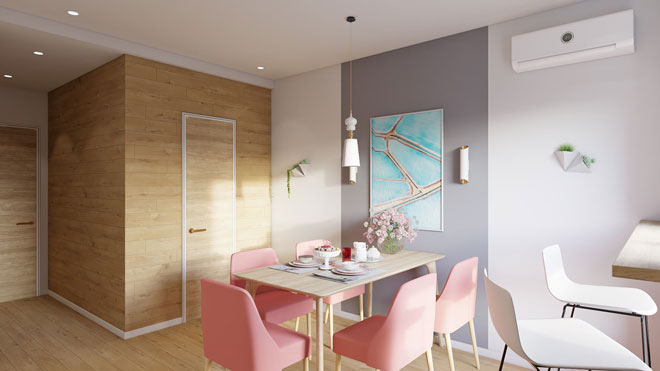
Stove or hob lighting
Plate illumination in 95% of cases is not needed because:
- General lighting is sufficient.
- Some models of stoves are available with backlight.
- The hostess or the owner of the kitchen does not need stove lighting at all, because the pots are visible anyway.
But if you need to supply the stove with lighting, we recommend that you turn to the built-in lighting, which is installed on the hood. As a light source, point mini-lamps or an LED strip are selected, which frames the contour of the hood.
Interior lighting for kitchen cabinets
Sometimes kitchens lack neither general light nor spot light. In this case, another kind of lighting was invented - the internal lighting of kitchen cabinets. Installing such an add-on will make it easier to find the necessary seasonings, ingredients or cutlery.
However, it is worth knowing that the lighting will perform functional tasks rather in the lower and more in-depth drawers and cabinets than in those located high on the walls.
Upper cabinets are supplied with LED lighting in case the owner of the kitchen wants to further decorate the room. It looks good inside those cabinets whose doors are glass or made of translucent materials. In some cases, this combination even slightly visually increases the size of the kitchen.
There are no special rules for installing LED strips or mini spotlights. They are mounted at your own discretion: put at least at the top, at least at the bottom, at least attach to the glass, if you wish.
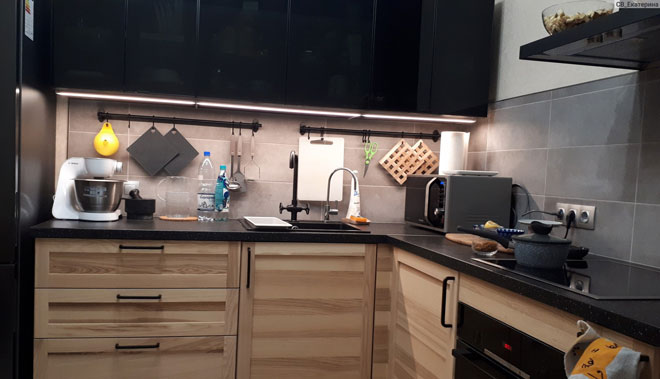
Decorative lighting ideas in the kitchen
Decorative design of kitchens with light is the choice of those who wish to create additional comfort in the room. This type of illumination does not play a role either for the eating area or for the food preparation area. It does not carry any load and has no installation rules, just like mounting LEDs in cabinets.
If desired, you can use an LED strip by constructing a multi-level ceiling. By installing it between the kitchen set and the second level of the ceiling, we get a visually expanded room. This looks especially impressive in miniature kitchens, where there is no place for bulky pendant lights.
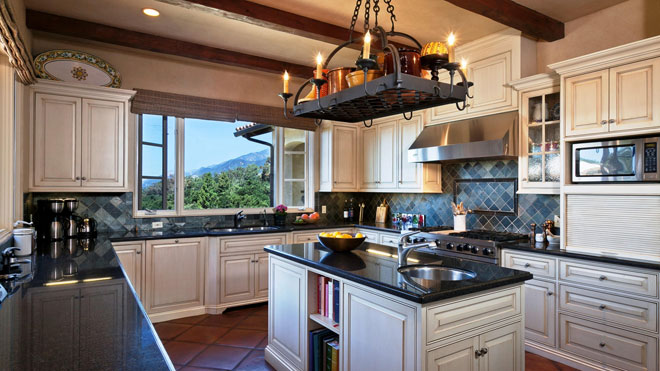
Another good option is to frame the basement of kitchen furniture around the perimeter. led strip or spotlights. This will give the impression that the framed pieces of furniture seem to be floating in the air. If there are paintings, they are also framed along the contour.
Dark and small kitchens are equipped with decorative sconces. They are placed on the wall in a row, using 2-3 pieces. Thanks to them, the kitchen visually enlarges.
Kitchen-studios are also separated by light. In them zones are allocated in a similar way and accents are created on places and household items. The separators are:
- LED strips;
- light tapes embedded in the floor, walls or ceiling;
- rows of pendant lights;
- rows of sconces on the walls;
- lighting bar counters as space delimiters.

